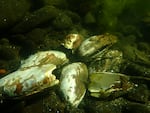A nonprofit conservation group has filed a petition for Endangered Species Act protections for a unique species of mussel that is vanishing from rivers and streams in the Pacific Northwest.
The Xerces Society for Invertebrate Conservation’s petition is aimed at improving the chances of survival for the western ridged mussel. It’s found in the Pacific Northwest, along with some areas in California and Nevada. The species can live for many decades in rivers and streams and provide many benefits such as filtering water where they are located.
When they’re young these mussels hook onto sculpin and other native fish. By doing this, they can expand into other parts of the river, where they bury themselves in the sediment and filter and clean the riverbed.
The Xerces Society, along with the other agencies and organizations like the U.S. Fish and Wildlife and the Confederated Tribes of Umatilla Indian Reservation, have been working on several projects over the last two decades to learn more about this unique species. Some of those projects include tracking and monitoring populations and investigating recent die-offs in different river basins.
A 2017 analysis that looked at historic versus recent distributing areas of the species and found that the populations have declined by almost 50% of its historic range and it has been accelerating in recent years.

Empty western ridged mussel shells from a recent die off found in John Day River in eastern Oregon in August 2020.
Teal Waterstrat / Teal Waterstrat
“We’ve been finding that populations of this species are being hit by some kind of unexplained die-off that’s causing many mussels to just die off over the course of a single event or sometimes over the course of several years,” Xerces Society Senior Conservation Biologist Emilie Blevins said.
Blevins said the species can live for many decades and reach a mature age for reproduction in 15 years. She said the recent massive die-offs are alarming and ESA protections are needed in order to learn more about the species and its threats.
Some of those threats include habitat destruction and degradation, impacts to water quality and quantity, pollution, warming rivers due to climate change, inadequate protection from recreational harvest and invasive species.
Mussels often look like rocks and can be hard to see. As such, they can be unintentionally destroyed by in-water construction work — even when Pacific Northwest rivers are being restored to help salmon recovery.
“These mussels are totally open to the river environment. They filter constantly. They spend their entire lives in the bottoms of rivers and so as a result anything that’s affecting a local river can be causing harm to these species,” Blevins said. “They can be very sensitive. They are able to really put up with a lot but drying rivers, polluted rivers, warm rivers, all those can have a real impact on them.”
Alexa Maine is the Fresh Water Mussel Project Biologist for the Confederated Tribes of the Umatilla Indian Reservation. She said the western ridged mussels are important in two ways; historically and culturally for the Umatilla Tribes and for the ecosystems they are found in. The tribes traditionally boiled or dried the mussels in the fall and stored them over winter as a supplementary food supply. Their shells were also used for jewelry, beads, ornaments, and ceremonies.
“The cultural aspect is highly important and in the tribal culture we don’t separate the cultural importance from the ecological importance,” Maine said. “It has to do with this whole interconnection between the species and the river system. It’s like the house of cards, you take one away and the structure might be still stable but less stable.”
Maine called these mussels “the liver of the river” because of the way they filter and clean the water at a rate much higher than their body mass would suggest.
“If we can get more people on board and interested in mussels, I think we have a really good chance of helping these guys continue living and helping rivers,” Maine said. “They can only help, they can’t hurt. If we can help them, they can help us.”
